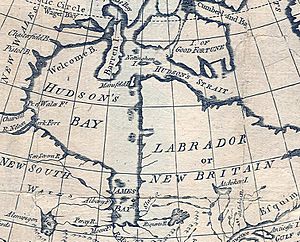Battle of Fort Albany (1709) facts for kids
Quick facts for kids Battle of Fort Albany |
|||||||
|---|---|---|---|---|---|---|---|
| Part of Queen Anne's War | |||||||
 A map from 1779 showing eastern North America. Fort Albany is at the bottom. |
|||||||
|
|||||||
| Belligerents | |||||||
| Commanders and leaders | |||||||
| Strength | |||||||
| Unknown | 70 French militiamen 30 Mohawk warriors |
||||||
| Casualties and losses | |||||||
| 2 killed | 18 killed | ||||||
The Battle of Fort Albany happened around June 26, 1709. It was an attack by French settlers and their Native American allies. They targeted Fort Albany, an outpost of the Hudson's Bay Company in what is now northern Canada. About 70 Frenchmen and 30 Native American warriors attacked the fort. It was defended by John Fullartine and his team. Fullartine's forces successfully fought off the attack. They killed eighteen attackers, including their leaders. The defenders lost two men who were ambushed outside the fort.
Why the Battle Happened
The Hudson's Bay Company was started by English investors in 1670. They set up a very profitable fur trade around Hudson Bay. By the early 1680s, the company had built several trading posts. These posts were near the mouths of rivers flowing into the bay. Native Americans living in these areas would bring their furs to trade. In return, they received supplies and European goods. These goods included weapons, ammunition, and other items.
The success of this trade caught the attention of New France. French leaders did not like the English moving into lands they claimed. The English fur trade also hurt the French economy. So, starting in 1686, French raiders began attacking the English trading posts. This continued through the Nine Years' War (1689–97). In the English colonies, this war was called King William's War. The French often captured these forts and took the furs. By the end of that war, only one English outpost remained. This was Fort Albany, located near the Albany River.
When the War of the Spanish Succession began in 1702, the idea of attacking Fort Albany came up again. This war was known as Queen Anne's War in the English colonies. In 1709, a group of French colonists decided to launch a land attack on Fort Albany. The governor of New France, Philippe de Rigaud Vaudreuil, approved the raid. He even helped pay for it from his own money. The people who invested in the trip hoped to get their money back from the furs they would capture.
The leader of the expedition was Nicolas d'Ailleboust de Manthet. He was an experienced frontier fighter. Manthet gathered between 60 and 70 Frenchmen and 30 Caughnawaga Mohawk warriors. They set out, traveled down the Moose River (Ontario), and canoed along the James Bay coast. They arrived near Fort Albany in late June 1709.
The Fight at Fort Albany
Fort Albany was staffed by employees of the Hudson's Bay Company. Their leader was John Fullartine. He had worked for the company for a long time. He had even been a prisoner of the French during earlier raids.
Fullartine learned about the French attack from Cree traders. This gave him time to get ready to defend the fort. We do not know exactly how many defenders there were. The exact date of the battle is also not clear from the old records.
All we know for sure is that the French attack failed. Both Manthet and his second-in-command were killed. In total, 18 French attackers died. This included their two leaders. The Hudson's Bay Company lost only two men. These two men were not inside the fort. They were ambushed by the French while trying to get back to it.
What Happened Next
The Hudson's Bay Company did not send a ship to Fort Albany in 1709. So, officials in London heard about the battle in an unexpected way. Francis Nicholson had led a failed expedition against New France in 1709. He brought three Mohawk chiefs and one Mahican chief to London in 1710. He hoped to get support for a new expedition. The Mohawk chiefs told company officials about the attack. They had learned about it because they were in Montreal when the French raiding party returned. Fullartine wrote a report about the event when he returned to England in 1711, but this report has been lost.
Governor Vaudreuil was criticized by government officials in Paris. They were unhappy about his role in supporting and funding the expedition. The Hudson's Bay Company got all of its outposts back in 1713. This happened with the Treaty of Utrecht, which ended the war. However, France and Great Britain continued to argue over their land claims in the following years.

